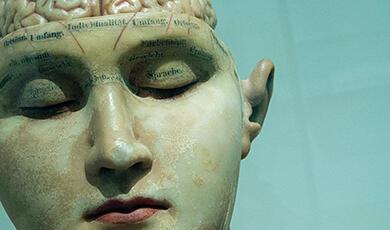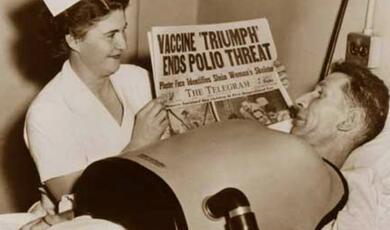Changing Minds and Changing Risk
Share
- Details
- Text
- Audio
- Downloads
- Extra Reading
In this talk, I explore the ethical issues that arise when people seek to change their minds. I discuss the political aspects of changing minds; the use of stories and media to create a change. I focus my talk on the process of changing "bad" minds into "better" minds, and the question of whether there is a duty to try and change people's minds when they have offended. I will ask if there is a right to be left alone to make bad choices, using examples from mental health case law.
Download Text
15 June 2016
Changing Minds and Changing Risk
Professor Gwen Adshead
Introduction
In this lecture, I want to look at the minds of those men and women who pose a danger others, and discuss how their minds can be changed. I begin by reviewing what I mean by violence, and what the features of the violent mind seem to be. I will discuss how dangerous minds develop, and how we might approach a change process. I will look at how positive change might take place, and conclude with some ethical questions about the right to therapy and or the duty to provide therapy for those who are violent. This lecture is based on a previous paper written with colleagues at Broadmoor Hospital (Adshead et al 2013) and I gratefully acknowledge their input and support for this work.
Background: what is a dangerous mind?
I am going to suggest that a dangerous mind is one that is one that is antisocial; in the sense of being anti-the-connections between members of a social group. I suggest that rules and laws are a manifestation of connections and agreements between people; and those who break rules and laws, are attacking the connection between themselves and the groups to which they belong. Attacks on group membership through rule breaking is likely to lead to expulsion from the group; and social isolation. The social exclusion and isolation process is strongest for those who break rules that forbid harming others, especially the vulnerable; and I shall discuss this further below.
The first objection to this suggestion is that it leaves no room for dissent or legitimate protest against rules and laws that are unfair or themselves antisocial. I agree that this is a strong objection, and especially agree that dissenters and protesters are always seen as dangerous by the ruling executive and the conservative status quo. However, I think this objection has less validity when we consider those who break rules forbidding violence or cruelty, and where direct harm to others is caused by their actions. I think those rule breakers are not mounting dissent or protest of a kind that we might consider to be pro-social in that it envisages alternatives rules and connections. Most social dissenters and protesters have an alternative pro-social nexus of connection in mind; they protest and break rules/laws because they believe that the status quo is failing in its pro-social objectives.
The type of antisocial dangerous mind on which I want to focus has no such alternate set of pro-social rules and beliefs. In fact, that antisocial person has no sense of the social; no sense of connection or attachments to others. They may have some rudimentary sense of value principles that might underpin rules; but little coherent account of how these rules and values relate to their sense of personal identity and moral identity. They do not lack a moral sense altogether, but their reasoning about the ethics and values that bind people together in groups is patchy and incoherent. Jonathan Glover describes people like that as socially alien, in ways that are not dissimilar to those who suffer from severe mental illness. (Glover 2014).
Violence and the antisocial
Violence accounts for 20% of recorded crime i.e. it represents a minority way of breaking social rules. The commonest type of recorded violence is drunken fights between young men; there are about one million of these each year ( CJS 2015). Weapons may or may not be used; gun crime is rare in the UK. The next commonest (also around the one million mark) is violence between intimate partners; 80% of which is committed by males to female partners. Sexual violence is next commonest but widely under-reported; it is thought that there are 10-20 000 rapes and sexual assaults each year but only 10% get to court. Physical violence to children is the next most common; again this rarely leads to criminal conviction but does account for some 40000 children being taken into care. The figure is complicated because physical abuse is often combined with neglect and sexual abuse; which rarely occurs on its own. Finally the least common of violence, but arguably the most serious, is fatal violence resulting in murder or manslaughter charges. There are about 600 per year in England and Wales; this figure has been fairly stable for 40 years.
In actuarial terms, identified risk factors for violence include male sex, young age, substance abuse and antisocial attitudes. Substance abuse is a potent risk factor for violence because it acts as a disinhibiting agent; and because it distorts reality so that the perpetrator loses the capacity discernment and judgement. Paranoid states of mind increase the risk of violence; these can be caused by some types of mental illness, but are also caused by substance misuse. Mental illness on its own is a rare cause of violence to others but combined with substance abuse it is risky (Vaughn et al 2011). Social isolation is a risk factor for violence, possibly because it increases a sense of threat; insecure attachment in childhood is also a known risk factor for violence, possibly because it increases social isolation and dysfunctional relationships (Ogilvie et al 2014).
Just as there are different forms of violence, there are different mental states that lead to violent action. It is helpful to distinguish between violence to strangers and violence to victims well known to the perpetrator, since motives and meaning may be very different in the two cases. Some violence is impulsive, uncontrolled and full of feeling; other violence is carefully planned, controlled and affectless. Some violence is reactive and is understood by the perpetrator as a response to threat and danger; other violence is proactive, and the victim is seen as prey or 'fair game'.
Group membership and the pro-social stance
We might think of the pro-social capacity as the capacity to live successfully with other humans in groups. Successful living in groups entails a number of psychological capabilities that have evolved over time. Perhaps the most important is the capacity for symbolic function and language, because this capability means that groups can become quite large, and there may be gaps in physical contact, without social bonds being lost. Communication is obviously crucial to making and maintaining human bonds and attachments across time and place.
Such attachments to others in groups have a profound effect on social life and effectiveness. Social isolation is associated with morbidity and early death in all primates, including humans. The ability to make reciprocal relationships that can survive conflict and tension has been shown to be vital to the social function of primate groups like baboons and chimpanzees (de Waal & Luttrell 1989; Silk, 2007). Bonds build group identity which can be protective when groups are in competition for resources and territory.
Attachment bonds are especially significant in the relationship between infants and their carers, and the development of the infant into adulthood. Attachment systems within the infant influence the development of stress regulation systems in the brains of developing infants, and provide a secure base for the development of stress response systems (Insel & Fernald 2006; Hofer, 1984; 2006). An infant who has a secure attachment bond will develop a stress response system that is 'good enough' to tolerate the anxiety of exploration away from their attachment figure; and by exploration learn and develop self-regulation.
Attachment systems develop within troops of primates to support protective behaviours in those situations in which a distressed and vulnerable member of the group might be singled out, attacked and killed. These systems are usually powerfully activated by any situation where an individual in distress requires assistance: is vulnerable or in need. Where there are established attachment bonds, adult carers and other adults respond with affects of concern and for distress. Where those bonds are not present, adults may respond with hostility in the case of a competitor and indifference in the case of a predator.
Human attachment systems resemble those in other mammalian species, especially in primates. Under evolutionary pressures, they have developed to help group members survive, compete with other groups; and protect themselves from predators. In humans, however, the attachment bio-behavioural systems have to be much more robust and extensive due to the extended period of vulnerability of the developing child. Human children remain vulnerable to danger for years, chiefly from other adults in the kinship troop; it is a sad fact that the humans who are most at risk of homicide by adults are babies under one year old (ref).
Human beings remain vulnerable throughout the life span: most commonly at times of illness or injury but also at times of distress associated with close relationships. Vulnerability is an inescapable part of the human life story, and attachment systems are needed to defend and protect against vulnerability. John Bowlby (1969) attributed the strength of this need to the extended period of immaturity in human development where the urgent subjective need for interpersonal proximity, triggered by fear, serves the evolutionary function of ensuring the child’s safety.
According to Bowlby (1988), attachments to particular individuals continue to be created in adulthood; especially in those situations where care giving is elicited. Expressions of distress and need activate the psychological attachment systems, which stimulate reciprocal care-eliciting and care giving activities, which are mediated by the neurobiological substrate of attachment as described above: especially oxytocin and dopamine reward systems.
Attachment activation and mentalising
In humans, the care-giving-care-eliciting dynamics between carer and child have both a neurophysiological and a psychological aspect (Cassidy et al 2013). The psychological attachment system involves a two-way process of communication and emotional marking called 'mentalising', or as Jon Allen (2006) puts it, 'Keeping mind in mind'. Mentalising is the process by which we perceive and think about other people as intentional beings, and the capacity for mentalising is built up in the attachment relationship between baby and carer. If the attachment relationship is good enough, it provides a secure base for the baby to develop cognitive models about other people's minds, and a trusting relationship with carers.
Bowlby (1969) called these models of thought about others 'internal working models'; and he argued that they act as a prompt for attachment behaviours at times of stress, such as proximity seeking i.e. if the internal working model of attachment is secure, the baby will seek care and attention when distressed, and can be soothed by contact with the carer. Another way to think of this is that attachment relationship is represented in the mind as a 'caregiver icon' (Kraemer, 1992) or what we might now call, an Attachment App. Stimulation of this 'Attachment App' stimulates mentalising about the mind of the other, which in turn helps relieve stress, and builds up an internal stress relieving system.
The mentalising process is therefore crucial to stress management because of its effect on emotional and arousal regulation. If you have a secure attachment system, when you are stressed you will seek care and attention; and trust that you need not be concerned about being vulnerable. This type of trust in the person looking after you is crucial, not only for safety, but also for the process of learning new information, including learning about one's own state of mind. Fonagy & Allison (2014) has called this 'epistemic trust', and sees it as essential for the transmission of cultural information; in addition, this level of trust also conveys a message about the acceptability of vulnerability, and reassurance that being vulnerable is normal and tolerable.
By contrast, those with insecure attachment systems lack a sense of trust and are not able to mentalise about their own minds and the minds of others. This is a huge topic, which cannot be adequately summarised here; interested readers are referred to excellent textbooks such as Allen & Fonagy (2006) and Cassidy & Shaver (2016). The key issue is that people with insecure attachment systems who lack epistemic trust are uncomfortable with vulnerability in themselves; and their violent behaviours/thinking patterns can be seen as maladaptive ways of dealing with vulnerability. There is a sub-group of insecure attachment ( called either dismissing/avoidant) which, when activated, attempts to switch off all feelings of need or distress; and this group in particular seems to be particularly common in violence perpetrators ( Pffaffin & Adshead, 2003).
Insecurity of attachment and dangerous minds
The relevance of this to dangerous minds is that insecure attachment patterns may result in conscious and unconscious attitudes to vulnerability in self and others that may increase the risk of violence to others. People with insecure attachment systems are not able to seek out care when stressed or mentalise positively about their minds and the minds of others; instead, any stress and experience of vulnerability leads to dysfunctional mentalising, and increased arousal and agitation. The experience of feeling vulnerable generates yet more stress, and conscious attitudes of anxiety, hostility or indifference, not care and concern for vulnerability and need.
Insecure attachment patterns should theoretically be a risk factor for violence to others for three reasons. First, any experience of vulnerability, either in self or others, may generate anger, anxiety and hostility in equal measure. Second, some people with insecure dismissing attachment may actually have contemptuous attitudes towards distress and vulnerability in others; a state of mind called 'derogation of attachment' (Meloy 2002). This variant of dismissing attachment is notable for its consciously expressed antagonism and contempt for weakness and vulnerability. Finally, those with insecure attachments may not be able to mentalise well in times of stress and distress; and may make cognitive errors when appraising situations. In particular, they may perceive others as being a threat to them if being with those others stimulates mistrust and feelings of vulnerability e.g. feeling vulnerable with a partner. In those situations, the insecurely attached person feeling vulnerable will perceive the other person as a threat; which will justify a show of hostility and attack.
These hypotheses based on attachment theory have some empirical data to support them. Studies of attachment security in violence perpetrators have found high levels of insecure attachment, especially dismissing attachment styles (Pfafflin & Adshead, 2003; Levinson & Fonagy 2004; Schimmenti et al 2014; Mcgauley et al 2011). A recent meta-analysis found that insecure attachment is a general risk factor for violence (Ogilvie et al 2014). Studies of mothers who harm their babies have found that they are more likely to have insecure attachment than non risky mothers, and again particularly likely to exhibit the dismissing attachment pattern (Adshead & Bluglass 2001, 2005).
An explanatory paradigm for violence based on insecurity of attachment does not explain or account for all violence between humans; but it does provide a theoretical explanation for violence between people who have been in close relationships where trust and attachment might be thought to be relevant: namely, violence between partners and violence to children. The majority of homicide victims have been in some close relationship of trust at some point in their lives with those who killed them; and violence between intimate partners accounts for over a million recorded assaults each year in England and Wales: this is likely to be an underestimate.
Relational violence is a major national and international problem; relational homicide accounts for a third of the homicide reported worldwide ( UNODC 2013). Violence to children from their parents not only causes direct harm to children, it significantly increases the risk of insecure attachment in the children so abused, and potential for transgenerational stories of family violence. Actual physical violence may be just the tip of the iceberg; children's attachment systems can be disorganised by persistent parental hostility towards them in the absence of any physical abuse ( Lyons Ruth et al 2005). Hostility towards children is likely to be associated with neglect, as well as other forms of abuse. A recent study of antisocial boys found that they reported more hostility in their fathers' gaze than prosocial boys ( Dadds et al 2012) .
Violence and affect regulation
The attachment and mentalisation model of mind would suggest that people with highly disorganised attachment systems may be at risk of failing to mentalise when their attachment histories are triggered. When this happens, and they feel small, vulnerable and distressed in the presence of others, then there may be associated painful and uncomfortable feelings that cannot be mentalised but are experienced in the body as physical discomfort which needs to evacuated. Shame is a potent source of emotional discomfort and a powerful predictor of violent acting out (Gilbert & McGuire, 1997; Gilligan, 2003); most probably because of its evolutionary roots in relation to appraisals of status and rank in social groups, where social status is associated with survival.
Violent offenders may be divided into a high affect, impulsive, and hyperaroused group on the one hand, and a low affect, hypoaroused and unemotional group on the other (Meloy, 2006). The high affect group resemble those patients who repeatedly harm themselves, who often meet criteria for a diagnosis of borderline or emotionally unstable borderline personality disorder (BPD). This similarity has led Bateman and Fonagy (2008) to propose that a sub-group of antisocial people resemble those with BPD, who can oscillate between reasonable reflective function and temporary losses of mentalising function with consequent fragmented self-experience and frightening affect storms. Such unstable oscillations of mental state are characteristic of disorganised attachment processes; in such a state, it may be impossible to make coherent (and safe) judgements about other people’s minds.
The low affect group seem to have little interest in anyone’s feelings, including their own, and most often are said to meet criteria for a diagnosis of Antisocial personality disorder (ASPD). There is some evidence that a sub-group of violence perpetrators feel satisfaction on seeing fear or distress in others; and experience a sense of mastery and control in the presence of others’ distress. Meloy describes this group as predatory; and this group do seem to function socially as if they were hunters and other people were (literally) ‘fair game’. Specifically, this group of violent offenders also appear to experience contempt and derogation for vulnerability, neediness and distress; even if this does reflect unconscious projection of vulnerability, it is reflects a conscious wish to hurt and control. Such states of mind are often seen as characteristics of psychopathy: a specific form of personality disorder in which meanness and cruelty to vulnerable others is a key factor (Patrick et al 2009).
The link between mentalising and violence is complex because some accounts of mentalising include psychological capacities such as empathy and the capacity to conceive of other minds (Choi- kain & Gunderson 2008). Failure of empathy is theoretically a key mechanism for violence commission (Joliffe & Farringdon, 2004), so prima facie this would indicate a failure of mentalising capacity. However, studies of empathy in offenders have mixed findings in terms of lack of empathy (Joliffe & Farringdon, 2004): not all violent offenders demonstrate lack of empathy and some offenders may actually score highly on empathy.
These two types of violence (high affect and low affect) mirror the current discussions about two different neuronal systems underlying empathy. Blair (2005) distinguishes emotional empathy and cognitive empathy; and there is evidence that there are two different systems involving the amygdala and orbitofrontal cortex that underpin empathic responses (Shamay Tsoory et al 2004; 2009).
Making minds more secure: intervention possibilities
Making violent minds more secure will involve a number of potential interventions, and a strategy that will operate in different settings. As stated above, poor mentalising function is only one of many risk factors that are active when a person acts violently and antisocially. If violence rates are to be reduced, other key risk factors will need interventions, especially (a) substance misuse and (b) social isolation. It will be obvious immediately that these factors are related to each other; those with an avoidant attachment pattern are more likely to be socially isolated, and severe substance misuse can also cause social isolation and rupture of social attachments.
Violence perpetrators are usually offered substance misuse interventions in prison or on probation; and they are usually encouraged to try and engage socially with others. Work placements and experience are crucial here in offender rehabilitation because of the social experience that they bring; and the message communicated to offenders about connection and pro-social identity. Violence perpetrators may also be offered interventions that help them think about distorted thinking patterns that they may have used in the past to justify violence commission. Such interventions also seek to help offenders think more about their minds as a whole, and help them become less impulsive.
Reducing impulsivity could be also understood as helping people to think before they act on a feeling. This is a fundamental aspect of therapies like Dialectical behaviour Therapy (DBT) and Mentalization Based Treatment (MBT), which has been shown to be highly effective in reducing impulsive self harming behaviours in people with BPD. Both DBT and MBT have been tested out as interventions with offenders, and MBT is currently being tested in a randomised controlled trial with offenders on probation with ASPD who are willing to volunteer. The overall aim of MBT is to provide a space in which the objective is to think about how thoughts and feelings dictate actions and also identify where errors in this process occur resulting in problematic reactions. Previous studies suggest that mentalisation based therapeutic techniques produce a decrease in affect storms, improved abilities to self-reflect and reductions in self-harming behaviours (Bateman & Fonagy 2005).
Group therapy is an important intervention for violence perpetrators because it is a directly and actively pro-social intervention. Just joining a group is a pro-social act; and exploring the ways that a group works activates pro-social engagement. Group therapy is a potent way to address feelings of shame and social isolation, although the process can be painful; I am reminded here of the man who said to me 'I don't want to be in a group with people like me'.
If therapy is successful, then participants may be more able to take responsibility for their actions in the past, and come to terms with the offender identity (Adshead et al 2014). I have discussed elsewhere how group therapy may help people to develop more coherent accounts of their offending experience, which in turn makes it more possible for them to plan for a safer future (Adshead, 2015).
Conclusion
I have attempted to review here the features of a violent mindset; how this develops in the context of insecure attachment and poor mentalising capacity; and what might be done to help. Questions remain about the ethics of asking violent offenders to change their minds. Do such people have a duty to change their minds when asked; or is there a right to remain in an antisocial state of mind? Alternatively is there a duty on the state of provide interventions that help people change their minds; especially if their liberty has been removed as part of their punishment. My own view is that the state does have such a duty; and that this is justified with reference to future benefits but also with respect to the victims who have gone before. If those who hurt them are helped to become safer in the future then the past hurts and suffering may not have been in vain.
© Professor Gwen Adshead, 2016
References
Adshead, G., & Bluglass, K. (2001). A vicious circle: transgenerational attachment representations in a case of factitious illness by proxy.Attachment & human development, 3(1), 77-95.
Adshead, G., & Bluglass, K. (2005). Attachment representations in mothers with abnormal illness behaviour by proxy. The British Journal of Psychiatry,187(4), 328-333.
Adshead, G., Moore, E., Humphrey, M., Wilson, C., & Tapp, J. (2013). The role of mentalising in the management of violence. Advances in psychiatric treatment, 19(1), 67-76.
Adshead, G., Ferrito, M., & Bose, S. (2015). Recovery after homicide narrative shifts in therapy with homicide perpetrators. Criminal justice and behavior, 42(1), 70-81.
Adshead, G. (2015). Safety in numbers: group therapy-based index offence work in secure psychiatric care. Psychoanalytic Psychotherapy, 29(3), 295-310.
Allen, J. G. (2006). Mentalizing in practice. Handbook of mentalization-based treatment, 3-30. in Allen, J. G., & Fonagy, P. (Eds.). (2006). The handbook of mentalization-based treatment. John Wiley & Sons.
Bateman, A., & Fonagy, P. (2005). Psychotherapy for borderline personality disorder. Oxford: Oxford University Press.
Bateman, A., & Fonagy, P. (2008). Comorbid antisocial and borderline personality disorders: mentalization‐based treatment. Journal of clinical psychology, 64(2), 181-194.
Blair, R. J. R. (2005). Responding to the emotions of others: dissociating forms of empathy through the study of typical and psychiatric populations.Consciousness and cognition, 14(4), 698-718.
Bowlby, J (1969) Attachment and Loss: Vol 1: Attachment. London, Hogarth.
Bowlby, J. (1988).A secure base: clinical applications of attachment theory. London Routledge..
Cassidy, J., Jones, J. D., & Shaver, P. R. (2013). Contributions of attachment theory and research: A framework for future research, translation, and policy. Development and psychopathology, 25(4pt2), 1415-1434.
Cassidy J & Shaver, P (eds) (2016). Handbook of Attachment: Theory, Research, and Clinical Applications. New York: Guilford Press.
Choi-Kain, L. W., & Gunderson, J. G. (2008). Mentalization: ontogeny, assessment, and application in the treatment of borderline personality disorder. American Journal of Psychiatry.
Dadds, M. R., Allen, J. L., Oliver, B. R., Faulkner, N., Legge, K., Moul, C., ... & Scott, S. (2012). Love, eye contact and the developmental origins of empathy v. psychopathy. The British Journal of Psychiatry, 200(3), 191-196.
Fonagy, P., & Allison, E. (2014). The role of mentalizing and epistemic trust in the therapeutic relationship. Psychotherapy, 51(3), 372.
Gilbert, P., & McGuire, M. T. (1998). Shame, status, and social roles: Psychobiology and evolution. Shame: Interpersonal behavior, psychopathology, and culture, 99-125.
Gilligan, J. (2003). Shame, guilt, and violence. Social Research, 1149-1180.
Glover, J (2014) Alien Landscapes? Interpreting Disordered Minds. Cambridge, Mass., Harvard University Press..
Hofer, M. A. (1984). Relationships as Regulators: A Psychobiologic Perspective on Bereavement*. Psychosomatic medicine, 46(3), 183-197.
Hofer, M. A. (2006). Psychobiological roots of early attachment. Current Directions in Psychological Science, 15(2), 84-88.
Insel, T. R., & Fernald, R. D. (2004). HOW THE BRAIN PROCESSES SOCIAL INFORMATION: Searching for the Social Brain*. Annu. Rev. Neurosci., 27, 697-722.
Jolliffe, D., & Farrington, D. P. (2004). Empathy and offending: A systematic review and meta-analysis. Aggression and violent behavior, 9(5), 441-476.
Kraemer, G. W. (1992). A psychobiological theory of attachment. Behavioral and Brain Sciences, 15(03), 493-511.
Levinson, A., & Fonagy, P. (2004). Offending and attachment: The relationship between interpersonal awareness and offending in a prison population with psychiatric disorder. Canadian Journal of Psychoanalysis,12(2), 225.
Lyons Ruth K., Yellin, C., Melnick, S., & Atwood, G. (2005). Expanding the concept of unresolved mental states: Hostile/helpless states of mind on the Adult Attachment Interview are associated with disrupted mother–infant communication and infant disorganization. Development and psychopathology, 17(01), 1-23.
McGauley, G., Yakeley, J., Williams, A., & Bateman, A. (2011). Attachment, mentalization and antisocial personality disorder: The possible contribution of mentalization-based treatment. European Journal of Psychotherapy & Counselling, 13(4), 371-393.
Meloy, J. R. (2002). Pathologies of attachment, violence, and criminality.Handbook of psychology.
Meloy, J. R. (2006). Empirical basis and forensic application of affective and predatory violence. Australian and New Zealand Journal of Psychiatry, 40(6-7), 539-547.
Ogilvie, C. A., Newman, E., Todd, L., & Peck, D. (2014). Attachment & violent offending: A meta-analysis. Aggression and violent behavior, 19(4), 322-339.
Patrick, C. J., Fowles, D. C., & Krueger, R. F. (2009). Triarchic conceptualization of psychopathy: Developmental origins of disinhibition, boldness, and meanness. Development and psychopathology, 21(03), 913-938.
Pfäfflin, F., & Adshead, G. (2003). A matter of security: The application of attachment theory to forensic psychiatry and psychotherapy (Vol. 25).London Jessica Kingsley Publishers.
Schimmenti, A., Passanisi, A., Pace, U., Manzella, S., Di Carlo, G., & Caretti, V. (2014). The relationship between attachment and psychopathy: a study with a sample of violent offenders. Current Psychology, 33(3), 256-270.
Shamay-Tsoory, S. G., Tomer, R., Goldsher, D., Berger, B. D., & Aharon-Peretz, J. (2004). Impairment in cognitive and affective empathy in patients with brain lesions: anatomical and cognitive correlates. Journal of clinical and experimental neuropsychology, 26(8), 1113-1127.
Shamay-Tsoory, S. G., Aharon-Peretz, J., & Perry, D. (2009). Two systems for empathy: a double dissociation between emotional and cognitive empathy in inferior frontal gyrus versus ventromedial prefrontal lesions. Brain, 132(3), 617-627.
Silk, J. B. (2007). The strategic dynamics of cooperation in primate groups.Advances in the Study of Behavior, 37, 1-42.
United Nations Office on Drugs and Crime, UNODC homicide statistics, http://www.unodc.org/
unodc/en/data 2013.
Vaughn, M. G., DeLisi, M., Gunter, T., Fu, Q., Beaver, K. M., Perron, B. E., & Howard, M. O. (2011). The severe 5%: A latent class analysis of the externalizing behavior spectrum in the United States. Journal of Criminal Justice, 39(1), 75-80.
De Waal, F. B., & Luttrell, L. M. (1988). Mechanisms of social reciprocity in three primate species: symmetrical relationship characteristics or cognition?.Ethology and Sociobiology, 9(2), 101-118.
Part of:
This event was on Wed, 15 Jun 2016
Support Gresham
Gresham College has offered an outstanding education to the public free of charge for over 400 years. Today, Gresham College plays an important role in fostering a love of learning and a greater understanding of ourselves and the world around us. Your donation will help to widen our reach and to broaden our audience, allowing more people to benefit from a high-quality education from some of the brightest minds.


 Login
Login







